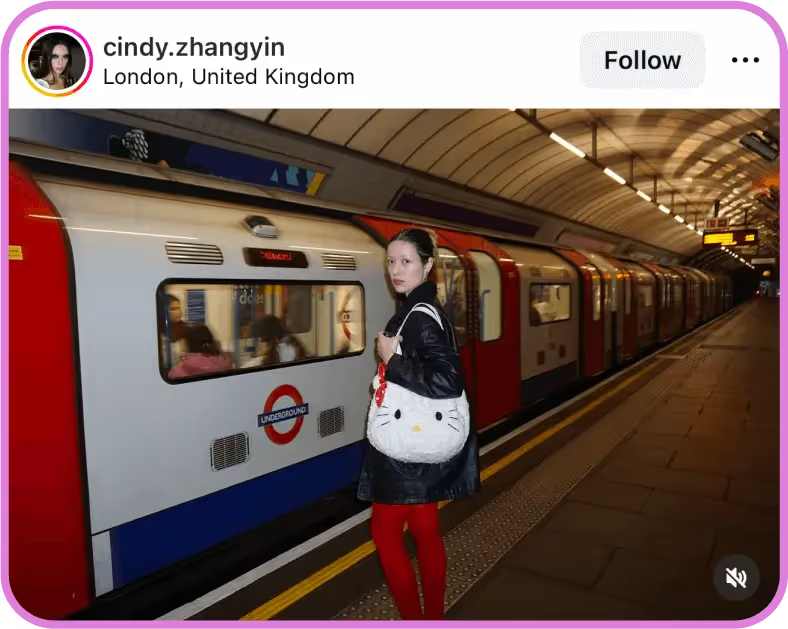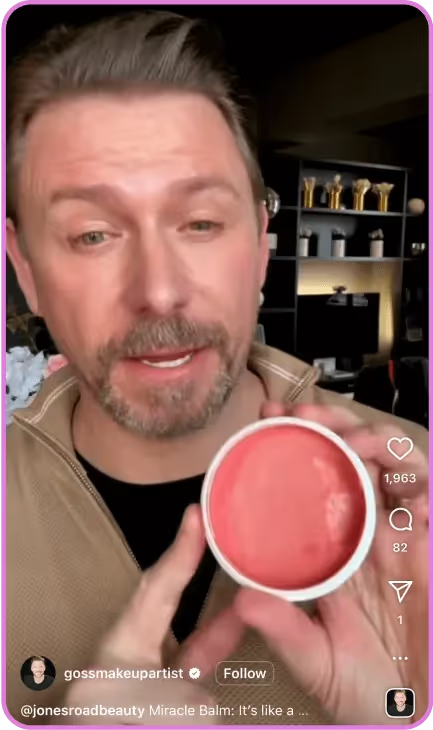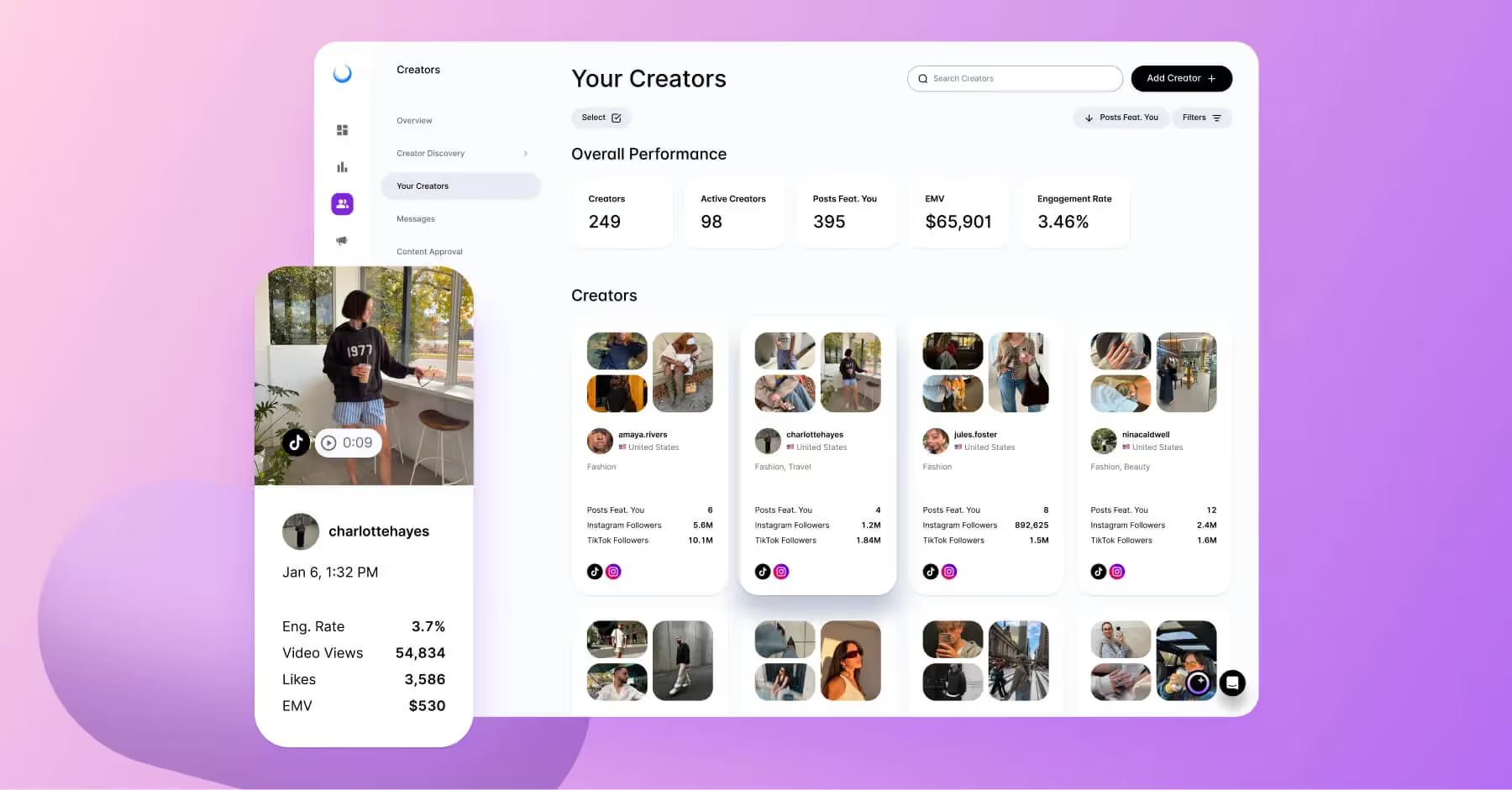What Is Influencer Marketing? An Essential Guide for Beginners
Influencer marketing is no longer an option it’s a necessity. Learn how to master your strategy with this guide.

Influencer marketing isn’t just a buzzword; it’s the backbone of today’s most talked-about brands. By partnering with creators who have spent years building loyal followings, brands can tap into ready-made audiences that are built to trust, engage and act on recommendations faster than you say “check out our new product!”. From nano to mega, influencers are shaping what’s trending and driving real results.
In this blog, we’ll break down what influencer marketing is, the best platforms for your brand, how to build a strategy that delivers results, what mistakes to avoid and much, much more.
TL;DR:
- You don’t need to work with the biggest, most followed influencers in the world to see ROI. Instead, focus on finding someone who fits your brand ethos and resonates with your audience to drive more fulfilling results.
- Don’t limit your influencer marketing strategy to just the ‘safe’ platforms like TikTok and Instagram. Utilize LinkedIn or YouTube to find your audience where they are (and where your competitors aren’t).
- Build your social strategy around your campaign and product, not your influencer. While building a campaign around an influencer may seem like the way to go, it can lead to issues if something falls through or doesn’t work out.
- Prioritize researching your potential influencer partnerships to ensure they are the perfect fit for your brand. By doing this, you’ll be able to have full trust in your influencer and their capabilities.
What Is Influencer Marketing?
Influencer marketing is a strategy based on partnerships between a brand and a social media influencer to promote a product or service. These partnerships can range from a simple mention in the influencer’s typical content to full-blown ad campaigns or commercials. Influencers are typically compensated through free products or monetary payment, depending on the type of deal, the size of the influencer’s following, influencer type, engagement and more.
Influencer marketing continues to be one of the most successful ways to reach your target audience and influence your customers. Brands should look for opportunities to partner with influencers at any and every chance to boost sales, foster community and maximize success on social.
Types of Social Media Influencers
Social media influencers are defined by their impact and persuasion on their audience's purchasing decisions and the size of their following. The size of an influencer's audience can help determine if that type of influencer aligns with your brand and campaign goals. Influencers with many followers will reach a broad audience, but might be too broad to reach your target audience. Influencers with a smaller following may have a narrow reach but a more dedicated and engaged community primed to purchase.
Each type of influencer plays a role in creating an impactful influencer marketing strategy. Below is a breakdown of the different types based on follower size and how each one impacts influencer marketing performance in its own way.
Nano-Influencers (0-10K Followers)
Nano-influencers are the smallest influencers of the bunch, but don’t let their petite follower count fool you. While they may not have the highest reach, they are some of the most passionate and impactful creators in terms of ROI. This is because they typically charge a cheaper rate due to their size, and they have fostered such a tight-knit community that really trusts their recommendations. Nano-influencers also often have a transparent and open dialogue with their followers, meaning the connection they have with their followers goes both ways, instead of being one-sided, which can happen with larger influencers.
Nano-influencer examples: Cindy Zhangyin, Jada Delgado, Amanda Joy Coleman, Jordan Slider

Micro-Influencers (10K-100K Followers)
Micro-influencers are a sweet spot when it comes to really successful influencer marketing. Like nano-influencers, they have a smaller audience size, making it easier to create those real back-and-forth connections. But unlike nano-influencers, micro-influencers are less limited to their small niche and have a broader reach overall. This type of influencer will cost a bit more, but you will see much higher engagement rates, followers and conversions due to the perfect mix of connection and reach that micro-influencers offer.
Micro-influencer examples: Breylan Poulsen, Jack Nader, Elizabeth Doupnik, Veronika Slowikowska

Micro-Influencers (10K-100K Followers)
Micro-influencers are a sweet spot when it comes to really successful influencer marketing. Like nano-influencers, they have a smaller audience size, making it easier to create those real back-and-forth connections. But unlike nano-influencers, micro-influencers are less limited to their small niche and have a broader reach overall. This type of influencer will cost a bit more, but you will see much higher engagement rates, followers and conversions due to the perfect mix of connection and reach that micro-influencers offer.
Micro-influencer examples: Breylan Poulsen, Jack Nader, Elizabeth Doupnik, Veronika Slowikowska

Mega-Influencers (1M+ Followers)
Mega-influencers are creators with the most significant number of followers and by far the most reach. This type of creator inspires influence far beyond social media, often creating social media trends that disperse throughout different landscapes, media types and industries, marking them as almost more of a celebrity than an influencer. While all brands would love to partner with a mega-influencer, it’s the most expensive and exclusive level of influencer to work with, making it a lofty commitment and partnership that is not easy to obtain.
Mega-influencer examples: Kylie Jenner, Selena Gomez (two of the most followed women on Instagram), Alix Earle, Mr. Beast

Benefits of Influencer Marketing
We could spend all day talking about each and every benefit of a solid influencer marketing strategy. Instead, we narrowed it down to the four benefits that will make the biggest impact on your brand today:
Boost Your EEAT
EEAT stands for Experience, Expertise, Authoritativeness, and Trustworthiness, four pillars your brand should embody both on and offline. Partnering with the right influencers can significantly strengthen each of these elements. When you collaborate with credible creators, their experience and expertise naturally elevate your content. As users see respected voices endorsing or engaging with your brand, it boosts your authority in the space. Ultimately, that’s how you build lasting trust with your audience.
Increase Brand Awareness
One of the main reasons any brand uses influencer marketing is to increase brand awareness. It’s consistently one of the most natural and semi-organic ways to show up in front of an untapped portion of your audience, or even better, an entirely new group of people who don’t know about you yet. Getting your brand in front of as many eyes as possible should be a primary goal for most, and influencer marketing makes that achievable.
Drive High-Quality Traffic
With brand awareness inevitably comes higher volume to your website. Luckily, the traffic that comes with influencer marketing is some of the highest quality you can obtain. This is for a few reasons, but mainly because of the intent and loyalty of an influencer's audience. Since the influencer has already established a level of authority, their audience trusts the products or services they recommend, making the path to purchase a no-brainer for them.
The Best Platforms for Influencer Marketing
Not all platforms are created or perform equally when it comes to influencer marketing. Some are built to be more conducive to the types of content influencers create, making them the perfect space for brands looking to improve their influencer marketing performance. These are the platforms you don’t want to miss:
TikTok
You knew this one was coming. TikTok is basically built on the back of influencer marketing, with creators ruling the app, influencing what’s trending and much, much more. It is a great first step for brands who don’t know where to get started with TikTok influencer marketing because there are so many creators, so much content and even more inspiration. It’s the perfect, all-encompassing influencer marketing platform that brands need to be using.
Instagram is a close second in terms of influencer marketing performance. Some may even say it takes the edge over TikTok. Instagram is the birthplace of the social media influencer, making it a natural choice for brands looking to amplify their influencer strategy. The way people use Instagram has changed, but what they’re looking for or who they’re following hasn’t. Influencers still play a major role on the platform, making it a mainstay in any successful influencer marketing strategy.
YouTube
We all know long-form content reigns supreme on YouTube, which presents an opportunity for brands to find and partner with unique influencers who are highly specialized experts in your niche. YouTube is known for its fiercely active and loyal communities (especially in relation to YouTube influencers), making it a hotspot for brands looking to use YouTube and influencer marketing on the platform for brand awareness, community building and to drive traffic.
Influencer marketing on Pinterest is at an all-time high. Even after all these years, users (including influencers themselves) still flock to the platform to create boards, source content and most importantly, look for inspiration from their favorite creators. Influencer marketing looks a little different on Pinterest in comparison to other platforms, with it playing a more subtle, background role instead of being directly in a user's face. But that doesn’t impact its overall effectiveness, making it one of the best platforms for influencer marketing.
You might be thinking, “LinkedIn? Really? For Influencers?” and the answer is yes, really. Obviously, this isn’t the perfect platform for brands in every industry, but it plays a major role in many B2C and B2B influencer marketing strategies. LinkedIn is full of experts and influencers, whose impact and influence on their communities is major. Before writing it off, do a deep dive into LinkedIn influencers and see who can match your niche. There is untapped potential waiting for you.
How To Build an Influencer Marketing Strategy in 6 Steps
Now, you understand almost everything you need to know about influencer marketing. Let’s now use that knowledge to create an actionable strategy that you can start today.
1. Understand Your Audience
For any strategy to be successful (but especially influencer marketing) you must understand the ins and the outs of your target audience. Dive deep into what types of content they like, what other brands they follow and of course, what influencers are they already obsessed with and following. Take things like location, gender and age into consideration when looking at your target audience so you segment audiences appropriately and find a creator who resonates with them.
2. Set Campaign Goals and Plans
Once you know your audience, it’s time to set some goals and get a campaign plan together. This may feel premature, especially since you haven’t chosen an influencer yet, but it’s much better to at least have an idea of these things laid out to share with prospects than nothing at all. It’s always recommended to have an influencer who fits into a campaign versus the other way around. This just ensures you don’t have to start from scratch if something with your chosen influencer falls through.
3. Find the Right Influencer
With goals in place and plans at the ready, it’s time to find your influencer. This can be done in many different ways, whether through hashtag research or a dedicated tool built for creator discovery. At this point, you will have an idea of exactly who you want based on your audience research, but we recommend having a list of 3-5 options you’d be happy with in case your top choices aren’t available. Once you have your list, it’s time for outreach!
4. Outreach and Seal the Deal
Outreach doesn’t have to be complicated. Just craft a simple and intriguing message to share with this influencer that shows what the campaign is and why you think they would be a good fit. You can either reach out to the influencer on their most popular platform or via email to their management team. After a bit of back and forth and maybe a call or two, you can move forward with the collaboration, swap contracts and officially get your partnership started.
5. Collaborate on and Map Out Your Campaign
Now you’ll have most of, if not your entire campaign, planned at this point, but be sure to leave room for some collaboration with your influencer. Walk through the goals, plans and process together. Be open to any feedback or suggestions they may have. And most importantly, allow them to be creative and have fun when creating assets for your campaign. These types of content often lead to viral magic and will be perfect for you to use on your feed or in paid social advertising.
6. Launch Your Campaign and Measure Performance
It’s officially time for launch. You should have all the assets you need well in advance to ensure everything goes smoothly for both you and your influencer. You can start measuring performance almost immediately as engagement, likes and comments start rolling in. We recommend keeping a close eye on performance every single day for at least the first week, and then you can slowly decrease your frequency as time goes on. Use your results to inform whether you would work with your influencer again.
Mistakes To Avoid When Working With Influencers (and How To Fix Them)
Unfortunately, nobody is perfect. Because of this, we’re naturally going to make mistakes when it comes to trying something new, especially influencer marketing. To help combat those mistakes, we’ve compiled a list of the most common influencer marketing blunders (and how to fix them) to help set you up for success.
Jumping Into a Big Campaign With No Experience
When starting out with influencer marketing, you want to do so with a big, splashy campaign that blows your numbers through the roof, right? Wrong. This is one of the fastest ways to overwhelm yourself, your team and possibly make some huge missteps.
The fix → Start out slow and small. Dip your toes into the world of influencer marketing by partnering with some smaller creators for single, one-off posts before diving into a full-blown campaign. This will give you the chance to learn each step of the process while the stakes are still relatively low.
Not Researching Your Partnerships Thoroughly
Let’s set the scene: Your latest influencer partnership just went live, and you’re so excited. Within minutes, your DM’s and comments are flooded with users in dismay over the fact that you would partner with an influencer who has made posts in the past that very much do not align with your brand ethos. Uh oh. Need we say more?
The fix → Research is the most important part of influencer marketing. You need to spend even more time than you think researching the influencers you plan on working with to avoid pushback or disappointment from your audience. More time spent on creator research in the beginning means less time spent on damage control in the end.
Having Undefined Goals and Expectations
It’s time to review your influencer's creative assets for your campaign. But they’re late. And there’s one missing. And another featuring the wrong product. How did this happen? Did you make it clear when these assets were due? And how many you needed? And what they were supposed to include? Maybe not.
The fix → Create an ironclad, cannot be misinterpreted, brief and contract that you review thoroughly with and have signed by your influencer. That way, both parties know exactly what is expected of them, what their deadlines are, how many assets they need to provide and what products they will be featuring.
Being Too Controlling
You’ve spent days, weeks or maybe even months planning the perfect campaign. Every post, video and detail is marked meticulously on your content calendar, and you do not want to deviate from it in the slightest. We get it, we relate to it, we envy it, but your influencer? They might not feel the same way and instead feel left out or uninspired.
The fix → Instead of just planning your entire campaign and handing it over to the influencer to take action, bring them into the fold as soon as possible to help with planning, content ideation and even goal setting. This lets the influencer share their creativity and feel more attached to the campaign and its results.
Prioritizing the Wrong Metrics
When it comes time to measure the performance of your influencer campaign or content, it’s important not to get tunnel vision about the metrics you want to focus on or measure success against. Conversion is a popular metric to prioritize when looking at campaign results, but it may not give the full picture of performance.
The fix → Make sure you have a wide range of metrics you will measure performance against. While conversion is a good one, look more closely at things like engagement rate, likes, comments, shares, follower growth and any other metrics you have that relate to brand awareness and community building.
Influencer Marketing FAQs
What does influencer marketing do?
Influencer marketing helps brands reach new audiences, drive sales and enhance their overall content strategy.
Does influencer marketing actually work?
Yes. Influencer marketing is an extremely effective way to increase reach, promote new products, broaden your community and see ROI.
Why is influencer marketing effective?
Influencer marketing is effective because it fosters real connections. Influencers and content creators are as successful as they are because the whole basis of their platform is to create a community full of people with similar interests. By leveraging that community to share products or services that they love, it’s a win-win-win for everyone: the influencer, their community and the brand.
How many followers do you need to become an influencer?
There is technically no lower limit to the number of followers a person needs to become an influencer. Nano-influencers are classified as having less than 10K followers, meaning that even if you have a very small following and are actively creating content like an influencer would, you are an influencer. Own your niche, create unique content and brands will find you!
Is influencer marketing dying?
No. Influencer marketing is not dying; it’s actually becoming more relevant and important than ever. Social media users are very savvy when it comes to being marketed to, and influencers build a level of respect that allows them to be trusted.
How can a business assess ROI from influencer marketing?
Assessing social media ROI from influencer marketing is one of the trickier aspects of your strategy, but not if you have a platform like Dash Social. With Creator Management, brands can see exactly how their creator content is performing and, even better, have access to exactly how much return on investment they are getting. This information can be used to guide influencer strategies moving forward and inform whether you want to keep or discontinue certain partnerships.






